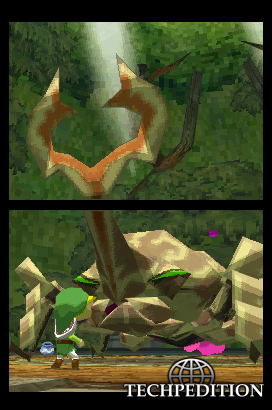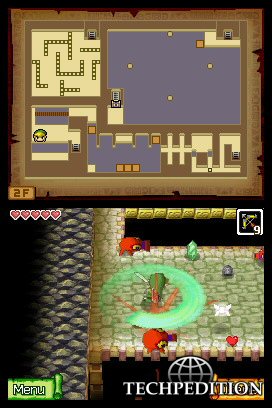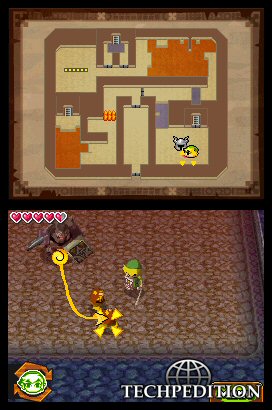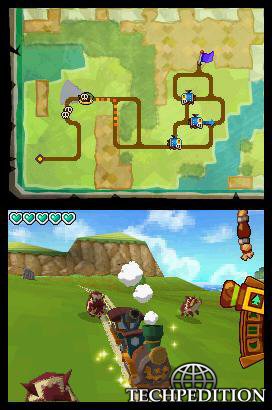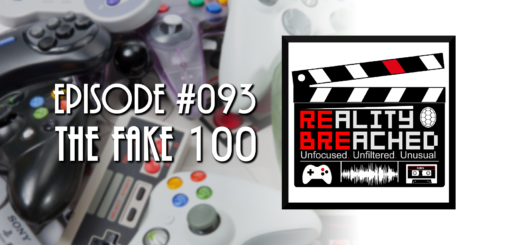Legend of Zelda: Spirit Tracks Review
 Links’ second adventure on the DS takes a lot of things from the first and classic Zelda puzzles and charm can be found throughout, but Spirit Tracks comes dangerously close to overstaying its welcome.
Links’ second adventure on the DS takes a lot of things from the first and classic Zelda puzzles and charm can be found throughout, but Spirit Tracks comes dangerously close to overstaying its welcome.
Ok, where do I start? Its another DS Zelda game. Like Phantom Hourglass, the entire game is controlled via stylus. Link is guided via touch screen and tapping on enemies and/or slashing the screen elicits attacks and actions. All of these mechanics work really well with very few buggy touch controls. The graphics are Cell-shaded much like the graphics in the Gamecube title the Windwaker, and like in almost every Zelda game you take control of “Link” before he gets his trademark green costume. Now, with that out of the way, everyone that has ever played a Zelda game knows the formula.
1. Go into a dungeon
2. Find item/weapon in dungeon.
3. Use new item/weapon to defeat the dungeon boss.
4. Rinse and repeat in next dungeon, repeat until game is complete.
Spirit Tracks doesn’t stray from this formula. In fact, if anything, the formula is even more pronounced through the layout of the map. Many of the weapons that have been staples of the series are here (I.E. Bow and Arrows, Boomerang, and Grappling Hook) and each Dungeon is full of familiar keys and buttons to use and press.
So what makes Spirit Tracks good? Well, a few things. The entire game is played with Zelda at your side. She’s a ghost whose body has been stolen by the main antagonist Malladus. The story is good but not interesting enough to cover here in the review. Most of the time Zelda only pops out during cutscenes and character conversations but during certain dungeons Zelda has the ability to possess a guard, granting you the ability to control two different characters. This adds a new level of depth to many of the puzzles and towards the end of the game can really put a strain on the old noodle.
Spirit Tracks’ boss battle are memorable and plentiful and the story has a nice pace that will easily keep your attention. The gimmick of the train is hard to get over, and almost doesn’t make sense in the context of the world. Actually the train is more of a footnote than anything. Only two train sequences were difficult enough to add depth to the game and the mechanic of using a vehicle to travel throughout the land had already been done better in the Phantom Hourglass (when it was a boat).
My only real issue with Spirit Tracks is its length. Its one of, if not the longest DS game I have ever played, but the way the map and story are structured, towards the end, the game lingers. Much like Okami, the final showdown seemed like an endless gauntlet of boss battles that added little to the overall experience. After dying on the final boss I put the game down for 48 hours and tried again only to find that it wasn’t the final boss and that the game had 4-5 additional sequences. These sequences were fun, but wildly unnecessary. I found myself hoping that the game was over when I finally finished off Malladus.
Long games are great, but they should never last longer than the game is interesting. I promise you, there is a large portion of Spirit Tracks owners who will play more than a majority of the game and simply stop before the end. However this is a small detail in a game that is an overall improvement over its predecessor, mainly because the hub dungeon isn’t excruciating like it was in Phantom Hourglass. I’m looking at you Temple of The Ocean King.
If you want to get your monies worth out of a DS game or if you have a Zelda itch you need to scratch, I highly recommend you grab this title for your DS. If you are new to the Zelda franchise, this title, while very representative of classic Zelda structure, will not truly immerse you in the world of Hyrule. Luckily, for that, we have this.
Verdict: Ignore the Sidequests

